Monday, December 10, 2012
Drawing the Human Hand
Monday, December 10, 2012 by tes
The hands, along with the face should recieve careful attention. for one thing, aside from the head, they are usually the only other exposed part of the body. Secondly, they are equally as expressive in gesture, emotion and action. Because of the complexity of joints, masses and planes, along with their expressive nature, the hands can, and usually are, the hardest thing to learn on the entire human form.
The first thing that most artists in training do wrong is they make the hands too small. Here is where the importance of head drawing comes in. If you know how to proportion the head into its proper units of measure, then you have also determined the units of measure for the hands. If you place your hand over your face, the tip of the fingers will start at the hair line, and the palm will end at the chin. This is your measuring device for the hand.
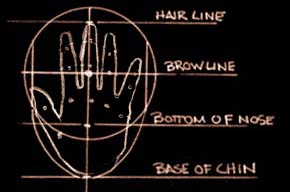
I hope the importance of figure drawing is really starting to sink in now. If you can draw the figure, you can essentially draw anything for two reasons; one, you have studied diligently in knowing that the human form consists of masses of solid shapes, and two, if you place a figure in a room full of things, you can use the figure as a measuring device to judge all of the objects in that room. You also know that these objects, like the figure, have mass.
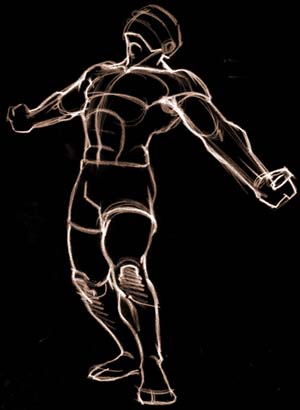
Back to the point- Composing the hand The hand has two masses, that of the thumb part, and that of the hand proper, or, the rest of the hand. The double rows of the carpel bones, or wrist bones are fused to the hand, making one mass. The wrist is not a floating mass, or ball joint like those of the wooden art dummies. The hand always moves with the wrist. Twice as wide as it is thick, the wrist gets a bit smaller where it joins the arm. You can also think of the wrist as a universal joint because of its side-to-side and up and down motion as well as all of its rotary movement.
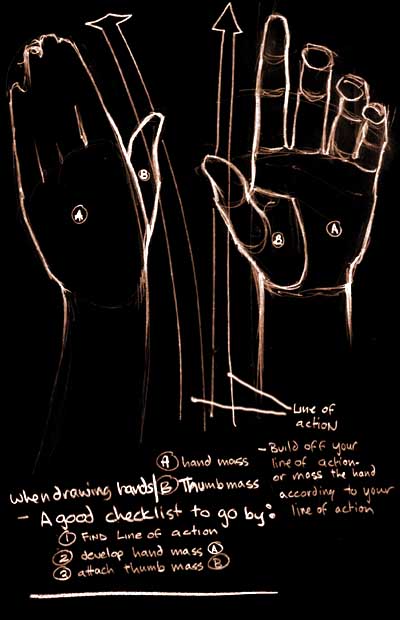
The center of the body of the hand is slightly below the body of the arm. For example, lay your arm and hand flat on a table, palm down, and notice that the wrist does not touch the table top. You will see the mass of the wrist rises from the hand at a slight angle where it joins the arm.
The thumb side of the hand is larger than the side of the little finger. The hand is broader at the fingers than at the wrist: however, at the wrist it is deeper. also notice on your own hand that the palm is longer than the back of the hand. The thumb is set into the palm by an independent and highly mobile "ball of the thumb", giving it a great range of movement independent from the rest of the hand. In the palm of the hand most of the modeling is caused by a system of cushions and pads, nicely "upholstered together. On the front of the thumbs and fingers, as well as a considerable area of the palm, the substance built upon the bony foundation is literally padding. The fingers all taper, with the middle finger, being the longest, forming the apex of the mass. Each finger itself tapers, with a tendency to converge toward the middle finger. Measured outside, the length of the thumb equals the length of the middle finger. The body of the thumb is heavier than the other fingers, but, but unlike them, only the last joint tapers. The sections of the fingers are more square than they would seem at first glance, with the last section containing the nail being quite triangular in shape, the nail with the flesh on either side forming its base. You will do well to memorize the anatomy of the hand and fingers for if you know the bone construction of the ahnd, you will never have trouble in drawing it with character and expression.
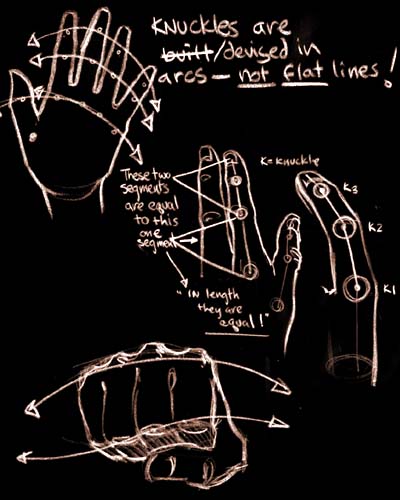
It is important to know the joints and their degree of limitation and movement. The first joint of the thumb and the first two joints of the fingers are hinge joints. Movement is limited to up and down, not side to side or rotational. Fully extended, the topmost joint of each finger is bent very slightly backwards. The lower joints of the fingers and the lower joint of the thumb will bend forward to an acute angle, while the upper joints or finger tips cannot bend even to a right angle. Review that really quickly the top two joints of all the fingers and the thumb are hinge joints, 90 degree motions only. The lower joint of the fingers and thumb, as well as the wrist are ball joints. You never need be at a loss for models of hands to study. Even when drawing, you have another hand to serve in that capacity at any time and as faithfully as you choose. The addition of a mirror in front of you in which to reflect your free hand will give you an infinite variety of poses to choose from.
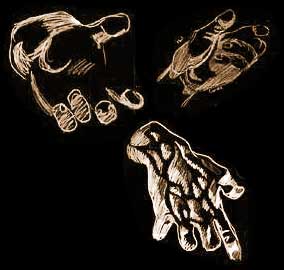
1. To draw the hand in action the first step is spacing and placing. You want to sketch in the action and approximate location of the hand, fitting each part as it appears.
2. Next solidify, or construct the shapes-the block method of drawing the hand is of great assistence in defining the planes and surfaces of the hands and fingers.
3. Next start to add the details. Carefully add the details of the hand and fingers erasing the first two steps as you go, and as they are no longer necessary, or they have already served their purpose.
4. Finally, add the tones, or light and dark planes. Reflective light applies here, so long as the shot calls for it.
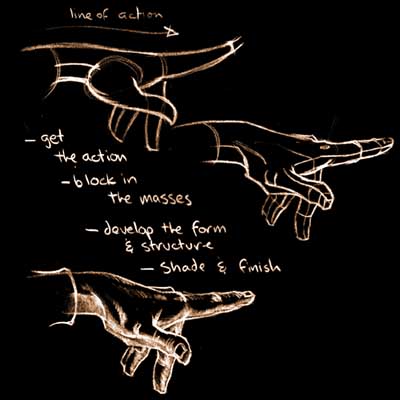
Memorize this stuff, get an anatomy book, and study. You will never stop studying the hand as you will probably never draw the same hands in the same pose twice. Every shot is a new lesson in hand construction, and a new journey or exploration into a great adventure of expression. Again, the hands are equally as important as the face. They require equal importance of attention and study as the head.
Hope this helps out a bit. Happy drawing.
Sumber : http://www.webdesign.org/ Tags: Design
Subscribe to:
Post Comments (Atom)


1 Responses to “Drawing the Human Hand”
December 28, 2015 at 11:56 PM
its nice sharing...!!!!
Crack Software | 4k stogram
Post a Comment